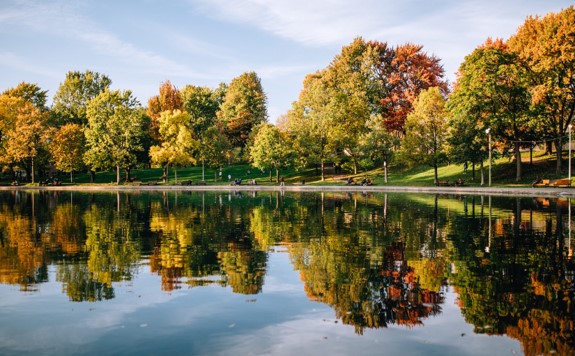
The importance of urban green and blue spaces for mental health
- Fri, 20/11/2020
Yesterday, the UNaLab project organised together with the Grow Green, Connecting Nature and CLEVER Cities projects a webinar on the importance of urban green and blue spaces for mental health. The webinar was very timely, as the ongoing COVID-19 pandemic has highlighted the importance of urban green and blue spaces for citizens' mental health.
Spending time in urban green and blue spaces provides numerous mental health benefits. Parks, playgrounds, rivers and other urban green and blue spaces have proven to promote mental health and well-being by reducing stress, stimulating cognitive function, enhancing social cohesion, and supporting physical activity.
The COVID-19 pandemic has caused countries across the world to implement social distancing and lockdown measures in order to curb the spread of the virus. Although these measures have proven successful, feelings of loneliness, anxiety and depression have reportedly increased among the world’s populations, particularly among people living in dense urban settings with limited public space. The restrictions have proven the importance of urban green and blue spaces, and many cities have seen an increase in the use of these spaces during the COVID-19 pandemic.
This was clearly highlighted in the presentation by James Hall on the 'Nearby Nature' study conducted by the Wildlife Trust for Lancashire, Manchester and North Merseyside, which proved that 99% of the respondents found that being connected with nature during the restrictions was 'very important' or 'important' to them. Some of the respondents said that being able to leave the house and go into nature was the highlight of the day and the one thing that saved their everyday life.
These results were echoed in the presentation by Annika Kettunen, who presented the results of a survey conducted in the Vuores area in the City of Tampere in Finland. According to the results, 36% of the respondents found that the COVID-19 pandemic had affected their habits of spending time outdoors in spring 2020. One of the reasons for this change was the remote working situation that many people found themselves in, which resulted in less time spent commuting to and from work. This time could instead be spent outdoors in nature. The replacement of gym classes with outdoor activities was also an important factor.
Ensuring access to nature for all citizens should thus be a fundamental strategy of cities, both when coping with the current health crisis as well as when planning future urban development. The Glasgow City Development Plan and the city's Open Space Strategy, presented by Gillian Dick, show that urban green and blue spaces are a key priority for the City of Glasgow. This was further highlighted in Rania Sermpezi's presentation on how the city collects data on a range of different indicators to support and deliver these plans.
The presentations can be accessed through the links below:
City of Glasgow (Gillian Dick & Rania Sermpezi) - available here.
City of Tampere (Annika Kettunen) - available here.
My Wild City (James Hall) - available here.
The link to the dashboard of the City of Glasgow is the following: https://glasgowgis.maps.arcgis.com/apps/dashboards/d11c42a0a9d2416ba231392e6798e0ba